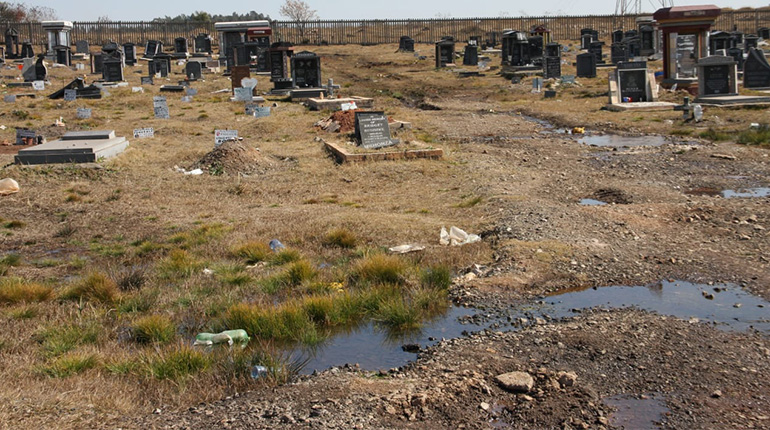
Mogale City Local Municipality has over an extended period experienced water ingress in some graves in the North-Western section of the Kagiso Cemetery located approximately 100m from a wetland system. Throughout this period, the municipality utilized other accessible areas in the cemetery for burials therefore grave digging and re-openings could go ahead without any hindrances.
The situation however significantly worsened in 2022 as the waterlogging spread from the initial estimated 2.7 hectares (ha) to other sections of the cemetery discovered when graves were dug, or pre-booked double graves re-opened.
With the assistance of civil engineers, the municipality subsequently investigated the source of the shallow water table, conducting numerous site visits and digging test pits to determine soil profiles and water ingress zones. During the latter part of December 2022, the situation further regressed due to heavy and constant rainfall in the area, resulting in elevated shallow water tables. These elevated water tables were observed at various natural wetland systems close to Rietvallei Extension 2 & 3, Rietvallei Extension 5, Tudor Shaft and several other areas.
Managing the waterlog crisis
As a means of continuing to meet the community’s constant need for burial sites while managing the water-logging challenges, affected sections of the cemetery were closed to the public and no graves were allocated in the said section, while a new burial section was developed in another unaffected part of the Kagiso Cemetery. All affected parties and stakeholders including the public and funeral undertakers were made aware of this situation at the time.
Opting for engineering solutions guided by professional assessments as a first priority rather than exhumation, the municipality is pleased to announce that funds to kick-start the Kagiso Cemetery Hydro Survey and Drainage Construction Project to ensure a permanent solution has been secured i.e. for implementation in the current financial year that commenced on 1 July 2023.
Exhumations
The municipality is not supportive of the exhumation approach and fulfilling such requests from community members until meetings have been held between key role-players i.e. the municipality, undertakers and community representatives – this is due to the nature of costs, required processes, health and other risks associated with performing exhumations. Furthermore, exhumations must fully follow regulated procedures as required in terms of Regulation 363 (Regulations relating to the management of human remains), promulgated in terms of Sections 68(1)(b) and 90(4)(c) of National Health Act, 2003 (Act 61 of 2003). In addition to this, the municipality’s recent exhumation process test resulted in the near collapse of adjacent graves due to the poor integrity of soils between grave sites. Considering this as well, exhumations may bear further legal risks and potential measureless liabilities.
Current Interventions and Way Forward
The shallow water table is a temporary phenomenon and through engineering interventions combined with natural hydrological processes, restoration of the waterlogged graveside can be resolved but it has to be exhaustively and professionally done.
Moving forward, it is anticipated that the following required work will unfold:
- The construction area will be secured and closed off to the public for the duration of the project
- Any re-openings in the construction area will be facilitated by an escort offered by the municipality’s Public Safety personnel or security
- Local labour can be sourced for back-filling as discussed with Ward 6 Councillor and community members
- The time frame for completion is unknown at this stage but the internal procurement process will soon commence
The patience of the affected parties is therefore important as we work on a permanent solution that would be sustainable from a social, economic and environmental point of view.
